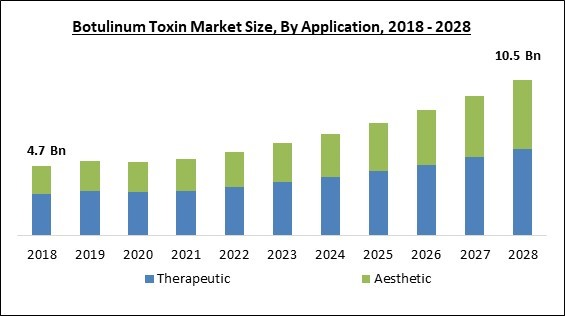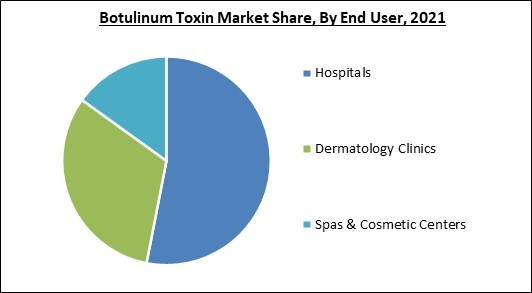The Global Botulinum Toxin Market size is expected to reach $10.5 billion by 2028, rising at a market growth of 10.8% CAGR during the forecast period.
Botulinum toxin is a neurotoxin, which is one of the most lethal biological chemicals created by the bacterium Clostridium botulinum. Eight exotoxins with distinct antigens are produced by botulinum C. The main neurotransmitter at the neuromuscular junction, acetylcholine, is blocked by all serotypes, interfering with neuronal transmission and paralyzing muscles. Botulinum toxin A injection-induced weakness often lasts for three months.
Strabismus, focal dystonia, hemifacial spasm, various spastic movement disorders, hyperhidrosis, headaches, hypersalivation, and some chronic conditions that only partially respond to medical treatment are just a few of the many medical conditions that can now be controlled with the help of botulinum toxins. The number of potential new symptoms is growing quickly. Cosmetologically applications as well as dermatological ones, like hyperhidrosis to correcting lines, creases, and wrinkles all over the face, neck, chin, and chest are benefitted with this compound.
Botulinum toxin injections are often well tolerated and have very few adverse effects. To effectively use botulinum toxins in clinical practice, one must possess a thorough understanding and expertise of the functional anatomy of the mimetic muscles. Botulinum toxin, one of the most toxic biological molecules, is also known as miracle poison. This neurotoxin is produced by the anaerobic, gram-positive rod-shaped bacterium Clostridium botulinum, which is typically found on plants, in soil, water, and animal intestinal tracts.
Botulinum toxin type A can effectively treat strabismus in humans. Botulinum toxin was subsequently authorized for the treatment of several spasticity problems as well as a variety of other ailments. It is currently utilized in practically all medical subspecialties. The FDA authorized the cosmetic use of Botox (Botulinum toxin-A) in 2002 to temporarily lessen glabellar forehead frown lines.
The market research report covers the analysis of key stake holders of the market. Key companies profiled in the report include Evolus, Inc. (Alphaeon Corporation), Merz Pharma GmbH & Co. KGaA, AbbVie, Inc., Ipsen Pharma, Galderma S.A., USWM, LLC, and Metabiologics, Inc. (Object Pharma).
Botulinum toxin is a neurotoxin, which is one of the most lethal biological chemicals created by the bacterium Clostridium botulinum. Eight exotoxins with distinct antigens are produced by botulinum C. The main neurotransmitter at the neuromuscular junction, acetylcholine, is blocked by all serotypes, interfering with neuronal transmission and paralyzing muscles. Botulinum toxin A injection-induced weakness often lasts for three months.
Strabismus, focal dystonia, hemifacial spasm, various spastic movement disorders, hyperhidrosis, headaches, hypersalivation, and some chronic conditions that only partially respond to medical treatment are just a few of the many medical conditions that can now be controlled with the help of botulinum toxins. The number of potential new symptoms is growing quickly. Cosmetologically applications as well as dermatological ones, like hyperhidrosis to correcting lines, creases, and wrinkles all over the face, neck, chin, and chest are benefitted with this compound.
Botulinum toxin injections are often well tolerated and have very few adverse effects. To effectively use botulinum toxins in clinical practice, one must possess a thorough understanding and expertise of the functional anatomy of the mimetic muscles. Botulinum toxin, one of the most toxic biological molecules, is also known as miracle poison. This neurotoxin is produced by the anaerobic, gram-positive rod-shaped bacterium Clostridium botulinum, which is typically found on plants, in soil, water, and animal intestinal tracts.
Botulinum toxin type A can effectively treat strabismus in humans. Botulinum toxin was subsequently authorized for the treatment of several spasticity problems as well as a variety of other ailments. It is currently utilized in practically all medical subspecialties. The FDA authorized the cosmetic use of Botox (Botulinum toxin-A) in 2002 to temporarily lessen glabellar forehead frown lines.
COVID-19 Impact Analysis
The demand-supply equilibrium across the whole healthcare sector was severely disrupted by the pandemic. The botulinum toxin market has been considerably impacted due to this abrupt burden on the worldwide healthcare infrastructure. Many cosmetic treatments and operations were initially put on hold as a result of domestic as well as international lockdowns that were imposed in the majority of countries. However, due to the higher demand during the pandemic, sales of botulinum toxins, like Botox, witnessed a spike. Many dermatologists and plastic surgeons attribute the growth to people with the desire to look their best for conferences and online meetings, as well as having more time to attend consultations and recover from treatments.Market Growth Factors
High Levels Of Effectiveness And Efficiency In Therapeutic And Cosmetic Applications
Botulinum toxin is considered to be primarily utilized to treat cosmetic diseases, however, its medicinal uses go far beyond this. Botulinum toxin is a successful alternative to conventional therapy for patients with chronic migraine, muscle spasms, reagent bladder, and hyperhidrosis. Additionally, it has been found that botulinum toxin is quite effective at reducing chronic pelvic discomfort in females with endometriosis. People who have undergone botulinum toxin therapy are able to maintain their mobility for as long as 11 months.Increasing Demand For Minimal Invasion
botulinum toxin is utilized to treat a variety of aging-related problems, including crow's feet, glabellar lines, forehead lines, and others. People over 40 are therefore more likely to experience these indicators of aging. Therefore, botulinum toxin operations are becoming increasingly popular among people between the ages of 40 and 54. Among the most common non-invasive rejuvenation techniques, injectable botulinum toxin, soft-tissue fillers, as well as chemical peels each have particular uses for enhancing facial appearances.Market Restraining Factors
Side Effects Related To The Use Of This Substance
Although botulinum toxin is typically regarded as safe when used in a clinical environment, it has the potential to have major negative effects. Botulinum toxin can most frequently be injected into the incorrect muscle group or over time can travel from the injection site, temporarily paralyzing undesired muscles. Unintentional paralysis of face muscles is the main cause of the side effects of cosmetic use. These include difficulty eating, muscle weakness, and partial facial paralysis.Product Outlook
On the basis of Product, the Botulinum Toxin Market is bifurcated into Type A and Type B. In 2021, the Type-A segment witnessed the biggest revenue share of the botulinum toxin market. The increase in the growth of the market is attributed to the rise in the number of cases of sialorrhea all over the world. There are a number of commercially available botulinum toxin type-A medications, including Botox and Dysport, that have undergone clinical testing and have been shown to be both safe and effective over the long term with the fewest side effects.Application Outlook
Based on Application, the Botulinum Toxin Market is divided into Therapeutic and Aesthetic. In 2021, the aesthetics segment recorded a significant revenue share of the botulinum toxin market. Botulinum toxin is a staple of the cosmetology toolbox. There have been more cosmetic procedures performed as a result of increased aesthetic consciousness and technology breakthroughs in both developed and developing nations.End-User Outlook
By End-User, the Botulinum Toxin Market is segregated into Hospitals, Dermatology Clinics, and Spas & Cosmetic Centers. In 2021, the spas and cosmetic centers segment recorded a substantial revenue share of the botulinum toxin market. The segment's growth is primarily attributed to a higher inclination for aesthetic operations in dermatological clinics, spas, and cosmetic centers.Regional Outlook
Region-Wise, the Botulinum Toxin Market is analyzed across North America, Europe, Asia-Pacific, and LAMEA. In 2021, North America dominated the botulinum toxin market with the largest revenue share. The growth of regional market is expanding due to rising disposable income as well as an increase in cosmetic operations. Moreover, there is a significant number of market players operating in the region, who are increasing their focus and efforts in order to fulfill the rising demands of customers.The market research report covers the analysis of key stake holders of the market. Key companies profiled in the report include Evolus, Inc. (Alphaeon Corporation), Merz Pharma GmbH & Co. KGaA, AbbVie, Inc., Ipsen Pharma, Galderma S.A., USWM, LLC, and Metabiologics, Inc. (Object Pharma).
Strategies deployed in Botulinum Toxin Market
- Jul-2021: Allergan plc, subsidiary of AbbVie, Inc. received the US FDA approval for its label expansion of BOTOX to include muscles in order to treat upper limb spasticity among adults. This acquisition aimed to complement the company's excellence in neurotoxin science and highlight the benefits of BOTOX in the treatment of upper limb spasticity.
- Nov-2020: Galderma expanded its geographical footprint in China with the launch of its Dysport. With this launch, the company aimed to highlight its commitment to introducing new innovations in the aesthetic market in order to grow while also fulfilling the demand of its customers across China.
- May-2020: AbbVie acquired Allergan, an American global pharmaceutical company. Under this acquisition, the company aimed to leverage growth prospects in neuroscience through the addition of Allergan's Botox therapeutics, Vraylar, and Ubrelvy.
- Oct-2019: Allergan plc, subsidiary of AbbVie, Inc. received the US FDA approval for its supplemental biologics license application for BOTOX to treat pediatric patients from age 2 years-17 years. This acquisition aimed to reinforce the approval of the 11th BOTOX therapeutic indication in the same year.
- Sep-2019: Ipsen received approval for expanded use of its Dysport for injection to provide treatment for upper limb spasticity among children of age 2 or older. Through this approval, the company aimed to complement its neurotoxin research legacy as well as its strategy to bring advancements in patient care.
- May-2019: Merz received European approval for the Xeomin, a symptomatic treatment option for chronic sialorrhea in adult patients. The new treatment aimed to aid patients in enhancing the quality of life of patients with sialorrhea.
- Feb-2019: Evolus received the US FDA approval for its Jeuveau. With the new Hi-Pure technology-built neurotoxin, the company aimed to offer enhanced aesthetics
- Jan-2018: Ipsen received approval for its DYSPORT THERAPEUTIC from Health Canada for the treatment of limb spasticity among pediatric patients in patients of age 2 or older. With this acquisition, the company aimed to offer a treatment that provides improved movement and stiffness.
Scope of the Study
Market Segments Covered in the Report:
By Product
- Type A
- Type B
By Application
- Therapeutic
- Aesthetic
By End User
- Hospitals
- Dermatology Clinics
- Spas & Cosmetic Centers
By Geography
- North America
- US
- Canada
- Mexico
- Rest of North America
- Europe
- Germany
- UK
- France
- Russia
- Spain
- Italy
- Rest of Europe
- Asia Pacific
- China
- Japan
- India
- South Korea
- Singapore
- Malaysia
- Rest of Asia Pacific
- LAMEA
- Brazil
- Argentina
- UAE
- Saudi Arabia
- South Africa
- Nigeria
- Rest of LAMEA
Key Market Players
List of Companies Profiled in the Report:
- Evolus, Inc. (Alphaeon Corporation)
- Merz Pharma GmbH & Co. KGaA
- AbbVie, Inc.
- Ipsen Pharma
- Galderma S.A.
- USWM, LLC
- Metabiologics, Inc. (Object Pharma)
Unique Offerings from the Publisher
- Exhaustive coverage
- The highest number of Market tables and figures
- Subscription-based model available
- Guaranteed best price
- Assured post sales research support with 10% customization free
Table of Contents
Chapter 1. Market Scope & Methodology
Chapter 2. Market Overview
Chapter 4. Global Botulinum Toxin Market by Product
Chapter 5. Global Botulinum Toxin Market by Application
Chapter 6. Global Botulinum Toxin Market by End User
Chapter 7. Global Botulinum Toxin Market by Region
Chapter 8. Company Profiles
Companies Mentioned
- Evolus, Inc. (Alphaeon Corporation)
- Merz Pharma GmbH & Co. KGaA
- AbbVie, Inc.
- Ipsen Pharma
- Galderma S.A.
- USWM, LLC
- Metabiologics, Inc. (Object Pharma)
Methodology

LOADING...










